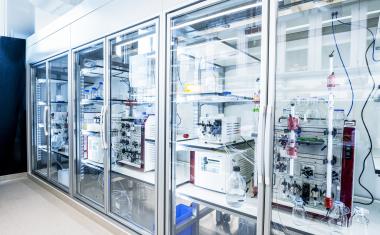Positioned for Growth: The New Age of Winning for Chemical Distributors
By enhancing offerings, ensuring performance, managing costs, and embracing sustainability, distributors prove as essential partners for long-term success amidst evolving challenges.

The 2023 chemical distribution survey shows recent trends and evolving principals’ expectations. It reveals a notable rise in third-party distributor usage across regions and chemical sectors. Principals require diversity in distributors and maintain the upward trend from previous years. They now demand higher distributor standards while being less tolerant of performance issues. These findings emphasize the need for adaptable chemical distributors. By enhancing offerings, ensuring performance, managing costs, and embracing sustainability, distributors prove as essential partners for long-term success amidst evolving challenges.
More than 300 global chemical principals and 20+ senior executives from leading distributors were surveyed to analyze market dynamics and chemical distributor performance and outlook. They represent all major regions as well as commodity and specialty companies. These results, building on BCG’s earlier reports on chemical distribution in 2018 and 2021, reveal six key findings about the industry’s current state and future.
1. APAC Is Key Driver for Positive Market Outlook
The chemical distribution market is expected to grow to €500 billion with a compound annual growth rate (CAGR) of 2.4% from 2022 to 2027. Rebounding from the Covid-19 pandemic, the chemical distribution market surged by 31.0% in 2022. 80% of this was driven by higher prices instead of volume resulting from tight product availability and supply chain disruptions, implying that future growth rates will normalize as price volatility stabilizes. However, we expect a slight decline of -0.5% in 2023, caused by overall lower demand for chemicals due to destocking among end customers especially in Europe and North America. After 2023, the global chemical distribution market is anticipated to recover with 1.4% growth in 2024 and a CAGR of 3.5% from 2025 to 2027, outpacing global GDP. We expect overall stronger growth for specialty vs. commodity chemical distribution.
APAC, representing around half the market, is poised for significant expansion of 3.1% CAGR from 2022 to 2027 and anticipated to catch up to the Western market in the next decade as rapid growth and industrialization in this region have led to improvements in local chemical distributors’ professionalization, supply reliability, service portfolios, technical know-how, and regulatory support.
Europe and North America have lower expected CAGRs of 0.9% and 1.5%, respectively, due to market maturity and saturation. Nevertheless, outsourcing trends are expected to persist, implying that the chemical distribution market outgrows the underlying chemical market.
“Principals perceive reliability and market access as even more important for their chemical distributors today than it was 2 years ago.”
2. Significant Increase in the Use of third Party Distributors
76% of all principals expect a substantial increase in their reliance on third-party distributors over the next three years, reflecting their ambition to establish strategic partnerships that leverage distributor expertise and networks for growth. Hence, the outsourcing trend, though slightly lower than 2021 (84%), continues to gain momentum with regional differentiation.
In China, 91% of respondents anticipate increased outsourcing, as do 84% in APAC. Asian principals seem to be using third-party distributors to expand globally, countering potential sales declines in their home markets. At the same time, we see shares of 75% and 68% of respondents in North America and Europe, respectively, that compare lower vs. 2021 signaling a potential refocus on direct sales but remain nevertheless high.
Despite recent disruptive events blocking relevant trade flows and inflationary pressures, approximately half of respondents maintained consistent outsourcing levels, demonstrating their unwavering confidence in the outsourcing model’s resilience.
3. Rising Outsourcing Share Heightens Principal Expectations
Over the past decade, the primary drivers for principals using third-party chemical distributors have remained the same: expanding geographic reach, focusing on core business, and reaching small customers.
Expanding geographic reach has increased in importance, as principals recognize the need for local expertise to navigate new markets successfully. Partnering with local third-party distributors allows them to establish a strong market presence, expand into untapped markets, and enhance customer satisfaction while focusing on their core business.
Interestingly, cost-to-serve reductions have become less prevalent in recent years, dropping from being perceived as a key driver by 63% of respondents in 2018 to 46% in 2023. The top drivers in 2023 overall signify a shift towards a more strategic approach, emphasizing the value and synergies distributors offer over cost savings.
“As chemical industry principals expand their distributor portfolios, they are redefining expectations for distributor performance.”
4. Principals Push for a Diversified Distributor Portfolio
A rising tendency among chemical industry principals is the diversification of their distributor base. 61% of all respondents expect further diversification over the next three years, tripling the past share. Principals seek to reduce reliance on a few distributors to promote competitive pricing and service quality while mitigating market instabilities across regions.
73% of commodity principals (vs. 51% of specialty principals) expect an increase in diversification, compared to 38% in 2021. The motivation for diversification varies: Commodity principals target different customer segments in various markets due to high volumes and limited differentiation, while specialty principals focus on leveraging distributors’ specialized expertise in specific niches, including application-specific knowledge accumulated over years.
5. Principals Expect Excellent Distributor Performance and Are Willing to Switch their Distributors
As chemical industry principals expand their distributor portfolios, they are redefining expectations for distributor performance. “Performance issues of distributors” and “lack of value-added services” are top concerns. Key performance factors for distributors encompass sales target achievement, financial management, service quality, and valuable market insights. Recent crises underscore the importance of adaptability, financial stability, and supply chain resilience. Additionally, principals seek out value-added services like logistics simplification, regional access, customer support, and product formulation support. In a competitive environment, principals also expect cost competitiveness, data transparency, customer data utilization, collaboration, open communication, responsiveness, and target commitment. Services like legal or regulatory support on sustainability matters also boost value and trust. In cases where distributors fail to live up to agreed standards, principals show increasing willingness to switch distributors if it advances their growth ambitions.
6. Sustainability Gains Traction in Chemical Distribution
Sustainability is gaining ground in chemical distribution, with 41% of principals aiming for more sustainable distributor product portfolios. However, only 10% of distributors actively push for it revealing room for improvement and greater commitment to sustainability.
Furthermore, sustainability targets are a must-have for distributors for 46% of principals. However, there’s a lack of clear guidelines, possibly due to the diverse nature of sustainability goals, allowing flexibility among distributors. Interestingly, 13% of all respondents rank sustainable return logistics as the second most important must-have, recognizing distributors’ unique role in reducing environmental impact through effective return management and potential in driving sustainability efforts beyond product-related concerns.
“A rising tendency among chemical industry principals is the diversification of their distributor base.”
Chemical Distributors Must Enhance Relevance to Principals
Based on the survey findings, there are four imperatives for chemical distributors to boost their bond with principals. Rigorous data management: In today’s digitally driven world, efficient data management is a critical factor setting chemical distributors apart. To achieve best-in-class status, distributors must have harmonized data systems and tools, facilitating seamless data flow for tasks like inventory management, compliance, and cloud-based transactions. Additionally, the ability to commercially leverage data is essential, allowing distributors to conduct customer data analyses for valuable insights and proactive responses to market trends. Harmonizing and leveraging data is crucial for adopting advanced technologies like Generative AI, which is making its way into chemical distribution. Early adaptation and exploration of use cases are necessary to gain a competitive edge, as principals increasingly favor innovative technologies.
Cost competitiveness: Global cost pressures impact both, principals and chemical distributors. Distributors must control major cost items, implementing efficiency measures in sourcing, logistics, headquarters, and sales teams to offer cost-effective solutions. Resource allocation to value-added activities is essential for competitiveness. Cost-competitive services will be crucial as customers prioritize cost-effectiveness in decision-making.
Value-added services and capabilities: In 2023, principals prioritize “reduction of logistics complexity” as the most important distributor attribute, followed by “access to new regions” and “customer support.” However, the overall importance of these attributes has decreased since 2021. In line with the overall trend, specialty principals still emphasize “reduction of logistics complexity” as the most important value-adding attribute, while commodity principals now focus on “access to new regions” to drive growth and expansion. Additionally, principals value distributors with top-tier laboratories, as they contribute to customer-centric and innovative solutions, elevating distributors beyond intermediaries to collaborative partners in process development for chemical principals.
Sustainability: In the current business environment, sustainability is paramount for principals, and they expect their distributors to align with their sustainability goals. Achieving this alignment is challenging due to differing business models, but distributors can use sustainability targets as a unique selling proposition. Through adjusting their product portfolios, conducting sustainability assessments, providing carbon footprint data, offering recycling solutions, promoting circularity, and assisting customers with sustainability regulations, distributors play a vital role in ensuring environmental friendliness throughout the supply chain.
Chemical distributors, who have navigated recent challenges are positioned for growth. Adapting to changing dynamics and prioritizing customer needs while aligning with principals’ expectations will be key to sustained growth in evolving global markets.
Adam Rothman, a Managing Director and Partner, BCG, Chicago, USA
Tobias Mahnke, a Managing Director and Partner, BCG, Munich, Germany
Madjar Navah, a Managing Director and Partner, BCG, Dusseldorf, Germany
Christian Hoffmann, a Partner and Director BCG, Hamburg, Germany
References to this article can be requested from the authors.








Company
BCG The Boston Consulting Group GmbHLudwigstr. 21
80539 München
Germany
most read

US Tariffs Fatal for European Pharma
Trump's tariff policy is a considerable burden and a break with previous practice.

Pharma 4.0 – the Key Enabler for Successful Digital Transformation in Pharma
Part 1: Building a Business Case for Pharma 4.0

ISPE Good Practice Guide: Validation 4.0
The Validation 4.0 Guide provides a comprehensive approach to ensuring product quality and patient safety throughout a pharmaceutical product's lifecycle.

ECA Foundation Aims to Become Largest Pharma Association for GMP/GDP Compliance
The ECA Foundation, one of the most important not-for-profit organizations for regulatory expertise in the pharmaceutical industry, aims to become the largest independent GMP/GDP organization in the world.

20 Years of CHEManager International
Incredible but true: CHEManager International is celebrating its 20th anniversary!











